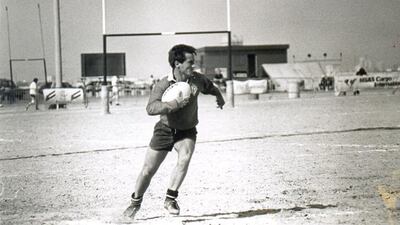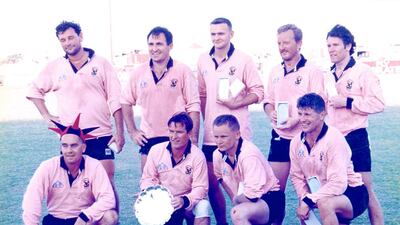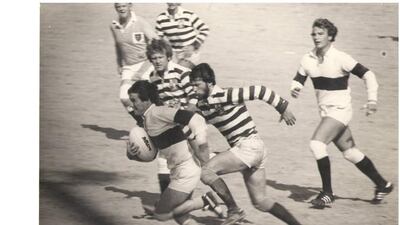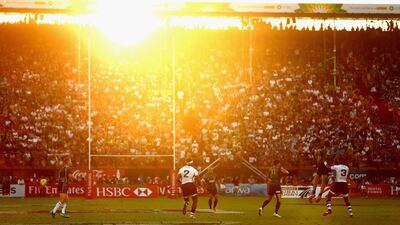DUBAI // Given how gloriously, sentimentally wedded to its past the Dubai Rugby Sevens is, its earliest history remains vague, and even possibly out of kilter.
The official website says: “When it began back in 1970, there were just a few players and a handful of fans scattered along the touchline. The Staffordshire Regiment were crowned the inaugural Dubai Rugby Sevens champions.”
They might have been, although one player with a very clear memory of the time reckons it was more likely they were actually the runners-up.
It is feasible there was more than one side representing the regiment, seeing as another of their servicemen from that time remembers his side as being “unbeatable”.
But it is highly unlikely they were champions in 1970. The Staffordshire Regiment were in Sharjah from March to December 1971, as the last unit of the British Army to serve in the Trucial States, before the formation of the United Arab Emirates.
“The dates are definitive: in 1970 I was patrolling the Berlin Wall,” said Charles Smethurst, whose photographs are some of the only lasting relics of the early Dubai Sevens, and they refer to the competition’s “runners-up”.
CLICK HERE FOR THE ENTIRE MEMORY LANE SERIES
“The sevens side we fielded was a scratch side made up from those who had previously played in Berlin,” he said.
“I would say that we were quite a fast side and that we were fit and acclimatised. The competition was a welcome break from the run of garrison duties.”
Army records are clear on the regiment’s date of deployment, but Smethurst has another reason to remember the time with great clarity, too. He was “courting” his future wife, who was a stewardess in the British Overseas Airways Corporation.
“Some people were touched by the desert and its way of life and applied to come out on contract to the Sultan’s Armed Forces in Muscat or the Abu Dhabi Defence Force,” he said.
“Others could not wait to get back home for Christmas. I met my wife on a weekend break in Bahrain and a couple of more times as she passed through Dubai on her way to Bombay.”
Gus Gordon, another former soldier who was serving in the Staffordshire Regiment at the time, remembers being part of a sevens team composed of both officers and non-commissioned officers who were “unbeatable”.
“Rugby is and was played throughout the military,” Gordon said. “We played wherever we were stationed and my team were champions in our division in the south-east of England.”
Reminiscing about that inaugural Dubai Sevens, Gordon said that it was not just a weekend activity. “We had trained hard for it in the blazing heat and humidity for months. I do remember it well.”
It is perhaps fair to assume the diverging accounts of that competition might have stemmed from the regiment’s split duties in the lead-up to the tour of Sharjah. Smethurst says his side was assembled from those who had served in Berlin the previous year, while Gordon had been deployed to Bahrain before arriving in the Trucial States.
Gordon recalls being billeted in a camp in Sharjah, where the regiment shared with a squadron from the Royal Air Force. Living conditions were basic.
There was none of the five-star luxury that is prevalent in the UAE today.
“I have been back a number of times and what is there now bears no relation to what it was then,” said Gordon, who now lives in Tangier in Morocco.
“Then there were just single-storey stone buildings and a souq where a lot of gold and silver was traded, which was contraband smuggled in from India and Pakistan. Our Navy was trying to stop this illegal trading, to no avail.”
Quibbling over these details of history does a disservice to a competition that remains commendably rapt by its past.
The community which has served rugby in the UAE for the past 45 years is arguably more transient than that which supports any major sport in the country. Yet the flagship competition remains laudably true to its roots.
When the advance of modernity forced the event — and thus rugby as a whole — to relocate further into the desert in 2008, measures were taken to preserve the most vital facets of the competition’s soul.
Chiefly, the organisers demanded it retain the atmosphere of the old Exiles ground in Al Awir.
As such, the outside pitches at The Sevens, the grounds on the Dubai to Al Ain motorway, remain in close vicinity to the main show field.
It means the social competitions which give the event its unique flavour are still on the same site as the main event, and run concurrently to it.
As at the old Exiles, which was consumed by construction of the Meydan project, there is one permanent structure adjacent to Pitch 1, where the changing rooms are situated, as well some basic concrete seating. But the vast majority of spectators on the Dubai Sevens weekend find their seats in temporary stands made of scaffolding, just as they did in the past.
The owners could easily have mandated the construction of a posh, permanent super-stadium. Perhaps something along the lines of the 25,000-capacity cricket stadium at Dubai Sports City, which was built at approximately the same time as the new rugby grounds.
Yet the scaffolding stands preserve the ambience of the past, as well as allowing for substantial attendances. During the Sevens weekend, for example, the ground regularly plays host to 45,000 supporters per day, while the likes of Cristiano Ronaldo, David Beckham, Justin Bieber and One Direction have attracted similar figures when they each performed there.
Obviously, there are substantial differences to the early days, too. Then, handfuls of spectators, who were likely friends of the players involved, went along to watch.
Now, many of the thousands who congregate for the event are tourists who arrive in the UAE specifically for the competition.
“I cannot believe it,” Gordon said of the competition’s advance. “We watched from the back of our lorries or stood on the touchline to cheer on our teams.
“We arrived changed and ready for action; there were no facilities such as dressing rooms or ablutions.”
No grass, either. For the majority of its history in the Middle East, rugby has been played on sand. Up until 1995, that was even the case at the Dubai Sevens, where the sand was rolled flat and the lines marked with bitumen.
Thanks to hefty investment by Emirates Airline, the pitches are now perfectly manicured grass, surfaces on which any professional side in the world would be glad to play.
According to Rory O’Connor, a long-term UAE resident who played for the Sharjah Pensioners and Barrelhouse in the early tournaments, the going was hard in those times.
“It was tough back then, playing on sand pitches with hard and soft patches,” O’Connor was quoted as saying in an article commemorating the 40th anniversary of the Dubai Sevens.
“It certainly wasn’t an even playing surface. It was hard work but a lot of fun and the tournament had a real community spirit. There was also such great camaraderie after the event.
“There was just a portakabin for a clubhouse when it first started, and before the final a Land Rover would drive up and down the pitch to smooth it out and you’d have to remark the pitch with lime paint because often the try-line had disappeared by that stage.”
Smethurst remembers wearing a pair of basketball shoes, with high sides to keep out the sand, when he turned out for the Staffords. Footwear was not the only item of equipment which required thought in the days of sand sevens.
“We used to wear knee protectors,” said Mehdi Honar, the current chairman of Bahrain RFC.
“I knew a couple of guys who used to play barefoot, because they found it easier to run. The sand was not too hot at that time of year.”
Honar first played in the 1974 Sevens, for a team called Ahvaz Gentlemen, which was a mixture of British expatriates and Iranians who worked together in his native Iran.
He played in the Sevens from 1974 to 1976, then every tournament from 1983 until 2014, by which time he was 63. It is not a bad record for someone who started out besotted by basketball, and only gave rugby a go when he was invited to join in with his work colleagues.
“I just fell in love with rugby,” Honar said. “You go onto the pitch, you hit each other, then you come off the pitch and become friends for life.”
Another lasting feature of the Sevens is the chance amateur players have to test themselves against some of the sport’s most recognisable players.
“We would play against some of the big names, with teams coming from New Zealand and Australia,” Honar said. “I don’t want to name drop, but I hooked against Hika Reid, who was the hooker for New Zealand.
“Even up through the mid-1980s, we would get to play against internationals. In those days, the Sevens was all about friendship, it was not that much about competition.
“You were playing against ex-All Blacks and they knew you were just from a small town. It was only about friendship, not about the name of the tournament or ‘I must win’.”
FOLLOW US ON TWITTER @NatSportUAE





